The dear cj and I were recently walking around Williams-Sonoma together. We pass a closeout table full with knives, spoons, towels, containers and other implements of culinary destruction when she exclaims, "Look! A fish boner!" After a moment's pause cj blushes and starts to giggle. A nearby customer laughs outright and I nearly fell to the floor after giving her the smirk. "Yes *snicker* dear, that is a lovely fish boning knife."
Sunday, October 14, 2018
Sunday, May 3, 2009
Homemade Spreadable Cheese
 Pioneer Woman has a great site. No, really, you should go check her out. We did! And as a result, we had "man-food" Saturday, with slow cooked beef brisket, onion strings, and scalloped potatoes. We legitimized the whole business by having something called "salad" on the side.
Pioneer Woman has a great site. No, really, you should go check her out. We did! And as a result, we had "man-food" Saturday, with slow cooked beef brisket, onion strings, and scalloped potatoes. We legitimized the whole business by having something called "salad" on the side.
In the Onion Strings recipe, it calls for two cups of buttermilk, or buttermilk substitute. You soak the onions for at least an hour in the buttermilk and then proceed with the recipe. But what becomes of the buttermilk? Since we almost doubled her recipe, we had a significant amount left over. Well. We are not to be out-pioneered!
The ingredients and the method:
3 or 4 cups leftover oniony buttermilk, pour into a non-aluminum sauce pot and slowly bring to temp just shy of a low boil. Add lemon juice 1/2 TB at a time until you see the curd separate from the whey. This shouldn't take more than 2 TB. For a softer/smoother cheese, use leftover whey from a previous cheese-making adventure, adding in the same manner as described with the lemon. Once curds start to separate, pull from heat and let cool for an hour. Once cool, line a colander with thin linen cloth (the tiny curds will go right through most standard cheesecloth), and set over a large bowl. Carefully pour contents of pan into colander. Let drain for 45 minutes to 1 hour. You can scrape up some of the solids from the bottom of the cloth to make it drain faster. We used a dull bamboo chopstick. Pull up corners of linen cloth, gently try to squeeze any excess liquid out. Tie linen with a string, and suspend the ball of almost-cheese (still wrapped in the linen) over a container in the refrigerator overnight. This will allow any remaining liquid to seep out of your cheese.
Pull up corners of linen cloth, gently try to squeeze any excess liquid out. Tie linen with a string, and suspend the ball of almost-cheese (still wrapped in the linen) over a container in the refrigerator overnight. This will allow any remaining liquid to seep out of your cheese.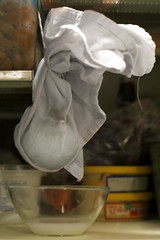 In the morning open your linen, put the ball of cheese in a container and gently scrape any excess off the cloth, this is good stuff you won't want to waste. Lightly sprinkle salt over your cheese, mix it in with a fork and repeat until you're pleased with the flavor. A few teaspoons of fresh herbs would have been delightful; think oregano, parsley, and especially chives.
In the morning open your linen, put the ball of cheese in a container and gently scrape any excess off the cloth, this is good stuff you won't want to waste. Lightly sprinkle salt over your cheese, mix it in with a fork and repeat until you're pleased with the flavor. A few teaspoons of fresh herbs would have been delightful; think oregano, parsley, and especially chives.
Posted by
calicojane
at
2:50 PM
1 comments
![]()
Monday, March 24, 2008
Escargot on Polenta with Asparagus
Escargot is not 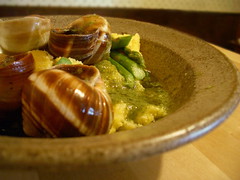 exactly at the top of many people's list of favorite foods. Maybe because it's not a common food (at least where I'm from!), maybe because it's difficult to get over the quasi-buggyness of the little creatures. I think it's a shame because when you look at what's actually in escargot, plus how it tastes, it really doesn't deserve the cringe we're probably giving it right now.
exactly at the top of many people's list of favorite foods. Maybe because it's not a common food (at least where I'm from!), maybe because it's difficult to get over the quasi-buggyness of the little creatures. I think it's a shame because when you look at what's actually in escargot, plus how it tastes, it really doesn't deserve the cringe we're probably giving it right now.
If you can get over the thought of "Eww! Garden pest!" you're in for a real treat. If you like mushrooms, particularly mushrooms in garlic butter, I promise you have all that's necessary to truly enjoy escargot. If you can't take the flavor or texture of mushrooms, well, you'd probably better move along.
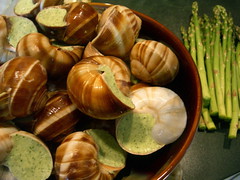 We are fortunate enough that our local farmers market fish seller carries ready-to-cook escargot stuffed with the traditional garlic-parsley-shallot butter at under $6 per dozen. The first of spring fruits and vegetables are also appearing. Here is a very easy (but impressive-looking) recipe for how I fixed them tonight:
We are fortunate enough that our local farmers market fish seller carries ready-to-cook escargot stuffed with the traditional garlic-parsley-shallot butter at under $6 per dozen. The first of spring fruits and vegetables are also appearing. Here is a very easy (but impressive-looking) recipe for how I fixed them tonight:Escargot on Polenta with Asparagus
For the polenta:
1 1/2 tsp sea salt
The rest:
2 dozen ready-to-cook escargot
1 bunch sweet young asparagus
1 TB butter or butter substitute
Very small amount olive oil in a mister (if you have such a thing, not strictly necessary)
Pop your escargot into the freezer just for a moment (this will make sense shortly). Preheat your oven to 400 degrees. Grease a large glass baking dish with the butter/butter substitute. After you've done that, rescue your escargot from the freezer, put them in a colander, and spray them down with cold water. Pick over them carefully for tiny fragments of shell that may have become dislodged. The minute in the freezer should have prevented any butter from falling out while you handle them.

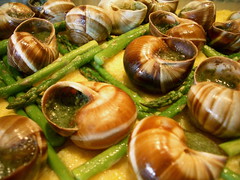 Arrange your asparagus spears and escargot (butter side up) however you like, mist lightly with olive oil then bake at 400 for about 15 minutes. The escargot should be bubbly and smell like garlicky heaven. Immediately divide into warm bowls- with a nice chunk of polenta/asparagus and six escargot on top, this recipe will serve four. The best part is that you get to pour out that lovely garlic-parsley-shallot butter stuffed into the escargot all over your polenta.
Arrange your asparagus spears and escargot (butter side up) however you like, mist lightly with olive oil then bake at 400 for about 15 minutes. The escargot should be bubbly and smell like garlicky heaven. Immediately divide into warm bowls- with a nice chunk of polenta/asparagus and six escargot on top, this recipe will serve four. The best part is that you get to pour out that lovely garlic-parsley-shallot butter stuffed into the escargot all over your polenta.
Posted by
calicojane
at
6:45 PM
1 comments
![]()
Tuesday, February 19, 2008
Chicken, Cubed: Three Dinners, One Bird
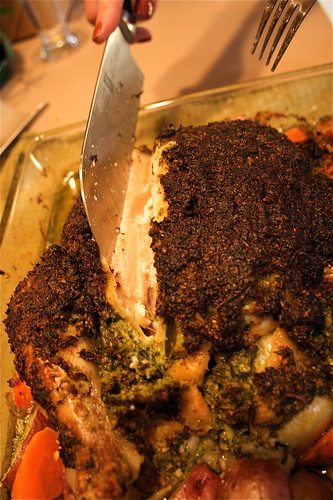 So, wow. Life has been eventful. Between getting married (good) and the electrical grounding cable to our entire house snapping (bad, so very bad) it's been tough to scrape a post together. Not that we've given up cooking, far from it! But blogging about cooking has a long list of tasks involved; in order to make recipes coherent requires us to be prepared or something approximating it. My computer got fried in a single stenchtastic zap (yes, it DID have a surge protector on it, you all can quit asking me that any time). So right now, the only thing I can prepare for on my little borrowed laptop computer is long periods of staring at the spinny rainbow circle OOOH SO PRETTY, the rainbow ball, it's still spinning!
So, wow. Life has been eventful. Between getting married (good) and the electrical grounding cable to our entire house snapping (bad, so very bad) it's been tough to scrape a post together. Not that we've given up cooking, far from it! But blogging about cooking has a long list of tasks involved; in order to make recipes coherent requires us to be prepared or something approximating it. My computer got fried in a single stenchtastic zap (yes, it DID have a surge protector on it, you all can quit asking me that any time). So right now, the only thing I can prepare for on my little borrowed laptop computer is long periods of staring at the spinny rainbow circle OOOH SO PRETTY, the rainbow ball, it's still spinning! Right. It's time to take care of a few items. First on the list is a shout-out to that wonderful place and wonderful group of people, our local farmers' market. Every week brings together a new assortment of the best nature has to offer. Can anyone explain why I went to Giant (local large chain supermarket) to buy free-range organic eggs from some distributor at least a hundred miles away, when I could have bought them at the farmers' market much fresher, larger, and only twenty-five cents more per dozen? I'm all about saving money when it's possible, but that was completely irrational. Take a naughty peek at some of the lovely items we rustled up.
Right. It's time to take care of a few items. First on the list is a shout-out to that wonderful place and wonderful group of people, our local farmers' market. Every week brings together a new assortment of the best nature has to offer. Can anyone explain why I went to Giant (local large chain supermarket) to buy free-range organic eggs from some distributor at least a hundred miles away, when I could have bought them at the farmers' market much fresher, larger, and only twenty-five cents more per dozen? I'm all about saving money when it's possible, but that was completely irrational. Take a naughty peek at some of the lovely items we rustled up.
One of our favorite stands had gorgeous sweet onions: thin, papery skins, with lush, firm, clear flesh underneath. I grabbed the largest basket of them before anyone else could get there. The lady at the counter looked puzzled and mildly horrified.
"What are you making with all those onions??" The truth was, I didn't know, except that they would be used (salsa, guacamole, frittatas, casseroles, stir fry, sammitches, soups, roasts... only every main dish we make). Although onions seem like something you could easily get at your "regular" supermarket stop, I can't tell you how many times I've brought home a bag of $0.69 per pound yellow onions, or even the expensive sweet ones, to find a few days later suspicious black mold creeping through so-called "fresh" onions.
Fresh, my ass.
Forgetting about or neglecting the mold for another day or two yields a layer of liquified onion slime just beneath the layer you'd ordinarily stop peeling at. Start slicing and, surprise!! The only solution is to throw out the whole bag and cut your losses. Tell me it's not worth another dollar per pound for onions you can actually use, and don't have to throw out in disgust? I like saving money but buying poor quality produce isn't the way to do it.
Which brings me to another point, that is, saving money. There's a balance we all need to maintain between living well and also living within our means. One argument is that going completely vegetarian cuts out a large unnecessary expense; the meat counter stop. We'll agree with that. Even while agreeing with our friends the vegetarians, we also acknowledge that we're not quite ready to make it an absolute in our lives. So when we want chicken, we have chicken, and don't go crazy trying to fight it. I buy a whole, free-running and "organic" as possible chicken and we use every bit of it, partly to make up for the added expense of buying more expensive poultry, and partly because I have ingrained cheapskate tendencies. Below is the first of three recipe installments using a four-pound chicken to make three meals for three people (that's two big people and one little) without driving anyone crazy with unappetizing leftovers. Most items should be available year-round in your local market.
Meal One:
Roast herby chicken with vegetables
1 whole chicken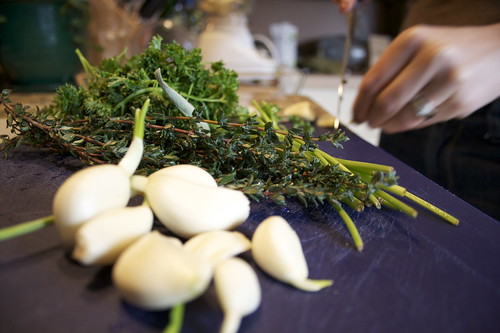 1 sweet onion, peeled and quartered
1 sweet onion, peeled and quartered
8 garlic cloves
1 or 2 celery stalks, with leaves
Mix of fresh herbs (not easy to go wrong with anything you find, but I usually have some combination of thyme, sage, rosemary, parsley, and basil)
5 small redskin potatoes, scrubbed and quartered
2 or 3 carrots, scrubbed and/or peeled, sliced
(Turnips are also good... so are sweet potatoes... or tiny boiling onions... and parsnips... butternut squash cubes... or brussels sprouts... don't be afraid to experiment, these are just the two I usually fall back on)
Sea salt and black pepper
Light olive oil
(optional) 1/2 cup white wine
Have one large glass oven baking dish as well as a large, heavy bottom stock pot at hand.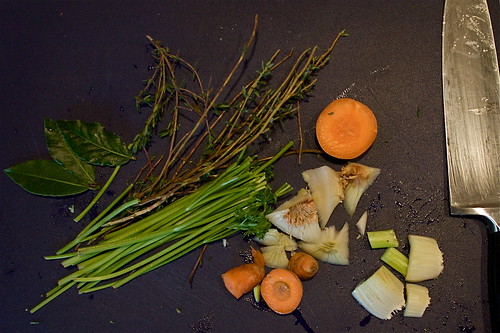 While you are preparing your roast chicken, keep an eye out for any clean bits of vegetables that you can throw into the stock pot for your soup. For example, don't throw away your parsley stems or the stalky twigs the thyme leaves grew on. They aren't pretty but there are delicious flavors contained in them. Even the tops of the carrots and the end bits of celery. Yes, it looks like something you should throw away, but we're going to take every last use out of them beforehand. Don't look at the contents of the stock pot. Just throw it all in there and trust me.
While you are preparing your roast chicken, keep an eye out for any clean bits of vegetables that you can throw into the stock pot for your soup. For example, don't throw away your parsley stems or the stalky twigs the thyme leaves grew on. They aren't pretty but there are delicious flavors contained in them. Even the tops of the carrots and the end bits of celery. Yes, it looks like something you should throw away, but we're going to take every last use out of them beforehand. Don't look at the contents of the stock pot. Just throw it all in there and trust me.
Pop the garlic cloves, one quarter of the onion, and the celery into a food processor (or chop the heck out of them to a fine crumb). When those are suitably teeny, add the herbs, salt, pepper and pulse. Add a drizzle of olive oil if needed to keep things going. Unwrap and rinse the chicken under cool water. Check for stray bits of ...well, anything that doesn't look like it belongs. Pull out the little baggy of "extras," remove from bag, and put them all into the stock pot without looking at them. There are some people who like to do other things with these pieces, and good for them too, but I'm not over some squeamishness about the "extras" (like, we put this chicken back together in the garage and had a few nuts and cables left over...?). I consider it a small victory to make them useful. If you are also this way, just close your eyes and throw them in the stock pot. Rinse the inside of the chicken. There, it's over. Fill your stock pot about halfway with water, add two bay leaves (they're in with your spices somewhere) and set it on a back burner on low.
Unwrap and rinse the chicken under cool water. Check for stray bits of ...well, anything that doesn't look like it belongs. Pull out the little baggy of "extras," remove from bag, and put them all into the stock pot without looking at them. There are some people who like to do other things with these pieces, and good for them too, but I'm not over some squeamishness about the "extras" (like, we put this chicken back together in the garage and had a few nuts and cables left over...?). I consider it a small victory to make them useful. If you are also this way, just close your eyes and throw them in the stock pot. Rinse the inside of the chicken. There, it's over. Fill your stock pot about halfway with water, add two bay leaves (they're in with your spices somewhere) and set it on a back burner on low. Put your chicken breast up (or breast down, don't flame war me) in the roasting dish and give her a good rub with your herby seasonings. If you're not a chicken skin eater, try to stuff some herbs under the skin so the flavor soaks down into the meat. Chop the remaining onion and mix with the vegetables you're using. If there is any herby mixture left, stir that in as well. Drizzle just a bit of olive oil (two or three tablespoons) over your vegetables and the white wine if you're using it. Arrange the vegetables evenly around your chicken. Sprinkle with salt and pepper.
Put your chicken breast up (or breast down, don't flame war me) in the roasting dish and give her a good rub with your herby seasonings. If you're not a chicken skin eater, try to stuff some herbs under the skin so the flavor soaks down into the meat. Chop the remaining onion and mix with the vegetables you're using. If there is any herby mixture left, stir that in as well. Drizzle just a bit of olive oil (two or three tablespoons) over your vegetables and the white wine if you're using it. Arrange the vegetables evenly around your chicken. Sprinkle with salt and pepper.
Cover with foil and bake at 375 degrees F for about an hour, uncover, then approximately 30 to 45 minutes more. A meat thermometer should read 185 degrees F and the juices should run clear when it's done. Let it settle for 10 minutes before carving.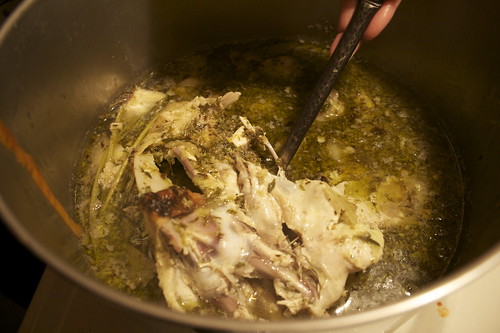 After your lovely roasty dinner, put on some romantic music, pour yourself another glass of wine (you deserve it), and take a few minutes to clean all the meat off of your chicken. It should be cool enough to handle by now. Don't try to kid yourself and say you'll do it tomorrow because you won't. When it's all cleaned, put all the bones into the stock pot with the other veggies which have been simmering happily for the last few hours. I usually put everything, skin and all, in the stock pot, because the flavors cook into the soup while the fat is easy to skim off after it cools. Cover, simmer on low (it should not be rattling the lid with a rolling boil, just an easy simmer), for at least two hours. Let it cool and "steep" for at least an hour before putting it in the fridge. Sometimes if there's a handy snow bank, we'll set the thing outside to cool further so the old fridge doesn't have to work so hard. Now, prop your feet up and forget about it for two days.
After your lovely roasty dinner, put on some romantic music, pour yourself another glass of wine (you deserve it), and take a few minutes to clean all the meat off of your chicken. It should be cool enough to handle by now. Don't try to kid yourself and say you'll do it tomorrow because you won't. When it's all cleaned, put all the bones into the stock pot with the other veggies which have been simmering happily for the last few hours. I usually put everything, skin and all, in the stock pot, because the flavors cook into the soup while the fat is easy to skim off after it cools. Cover, simmer on low (it should not be rattling the lid with a rolling boil, just an easy simmer), for at least two hours. Let it cool and "steep" for at least an hour before putting it in the fridge. Sometimes if there's a handy snow bank, we'll set the thing outside to cool further so the old fridge doesn't have to work so hard. Now, prop your feet up and forget about it for two days.
Up next, Meal Two:
Guinness BBQ chicken, rice, cheese, and baby greens warm wrap sandwiches
Then after that, Meal Three:
Soup with homemade and amazingly flavorful (without being over-salted) chicken stock
Posted by
calicojane
at
6:05 PM
2
comments
![]()
Monday, November 5, 2007
Another Romantic Evening...
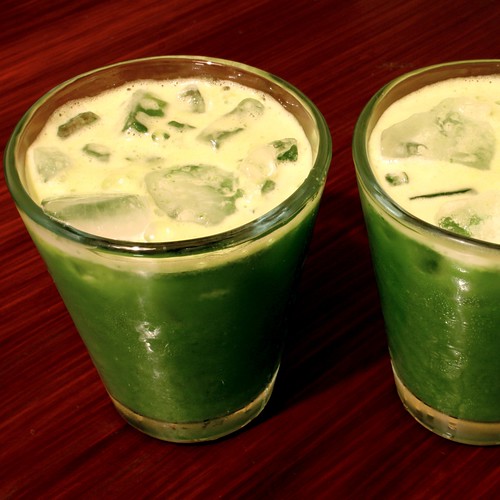 Tonight we both came home suffering from all sorts of angry back/neck/shoulder issues. As soon as I got my bag set on a chair, I popped an ibuprofen and an all-natural muscle relaxant. Not to be left behind, dear Vrai did so as well.
Tonight we both came home suffering from all sorts of angry back/neck/shoulder issues. As soon as I got my bag set on a chair, I popped an ibuprofen and an all-natural muscle relaxant. Not to be left behind, dear Vrai did so as well.
We had a particularly exhausting weekend including lots of impulse foods that tasted so darn good, but were definitely not healthy (including an embarrassing call-in order for takeout lasagna... the shame!). It left us feeling... ucky. Heavy, lethargic, and dense. Like mealy potatoes.
Our repentance tonight involves large quantities of fresh greenly juice. Cilantro, we've discovered, has some magical "freeing up" properties. "Freeing up," yes, I believe we'll call it that. After a light supper of crunchy, bright salads, we prepared this juice. We hope that you and your Lovah are close enough to enjoy a Lovahs walk, as well as a romantic evening, as we did, of muscle relaxants and laxatives. *Cheers!*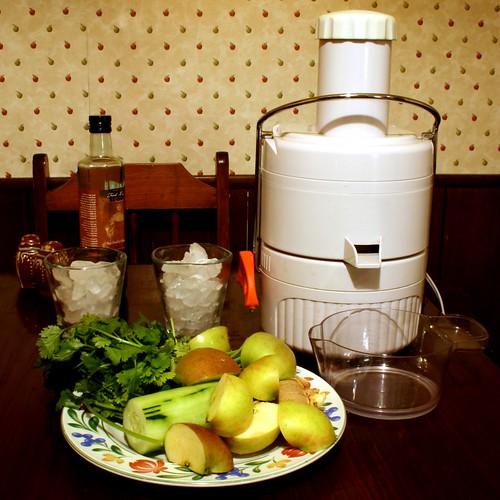 Penance Juice
Penance Juice
...for use after a weekend of loose living
1 cucumber, scrubbed and peeled
2 apples
1 large bunch cilantro
2 inch knob (or more) ginger
Sprinkle of sea salt, if you like
Run all ingredients through a juicer, except the salt. Add in just a teeny pinch of salt if you want and stir briefly before pouring into ice-filled glasses. Don't stray far from home for an hour or two. :)
Posted by
calicojane
at
9:21 PM
1 comments
![]()
Labels: "romantic evening", juice
Sunday, October 28, 2007
Green Rice
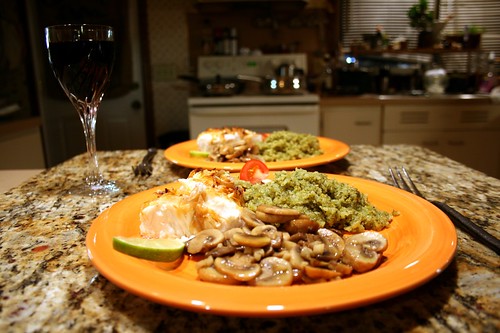 So last week we've been all, "Raw food, fnaar, fnaaaaar!" But do not fret! We haven't abandoned any of our favorite recipes. Fish with green rice is one of my very favorite meals. Quite a few friends have feasted upon green rice at my house! Because it takes some time and hassle to prepare, I always make a large batch. Unlike many rice dishes, this one tolerates reheating rather well. It's almost blissful in a black-bean burrito the next day. Since I can't invite you all over for dinner tonight, I'll share the recipe with you.
So last week we've been all, "Raw food, fnaar, fnaaaaar!" But do not fret! We haven't abandoned any of our favorite recipes. Fish with green rice is one of my very favorite meals. Quite a few friends have feasted upon green rice at my house! Because it takes some time and hassle to prepare, I always make a large batch. Unlike many rice dishes, this one tolerates reheating rather well. It's almost blissful in a black-bean burrito the next day. Since I can't invite you all over for dinner tonight, I'll share the recipe with you.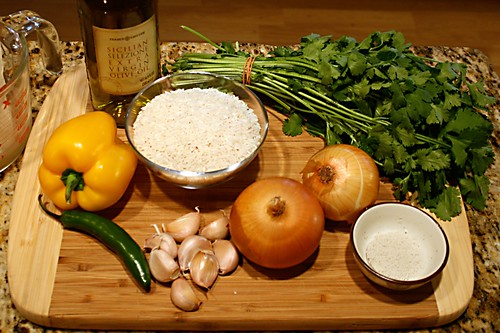 1 1/2 Cups long grain white rice (other rice will work, but this seems to be the best for this recipe)
1 1/2 Cups long grain white rice (other rice will work, but this seems to be the best for this recipe)
Generous 1/3 Cup virgin olive oil
1 green or yellow pepper (the sweet bell kind)
1 small *hot* green pepper (or more if you like!)
2 med/small onions
8 cloves garlic
1 bunch cilantro
2 Cups (plus possibly a bit more) good veggie broth
sea salt, to taste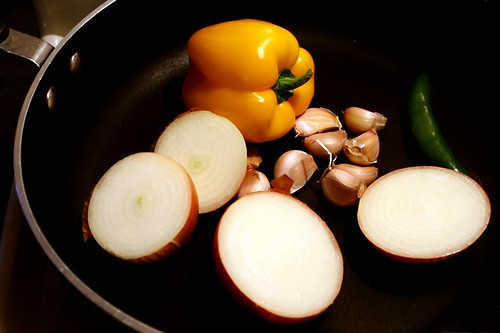 Find the heavy pan that is probably at the back of your pan collection. Choose the one that is not your favorite, and preferably non-teflon. You know, the one that always looks somewhat dirty because you forgot and left it on High while you answered the phone and it was your best friend, long distance. Oh, you never did that? Well, find an ugly pan anyway because it won't be any prettier after we're done with it today.
Find the heavy pan that is probably at the back of your pan collection. Choose the one that is not your favorite, and preferably non-teflon. You know, the one that always looks somewhat dirty because you forgot and left it on High while you answered the phone and it was your best friend, long distance. Oh, you never did that? Well, find an ugly pan anyway because it won't be any prettier after we're done with it today. Heat that pan up to medium-high and put in the peppers, halved onions (unpeeled), and unpeeled garlic. Char them on all sides, yes, char. Turn them occasionally. If you have gas burners, your job is made easy. Stab your pepper and hold it over the flame until the skin is evenly burned. It will probably smell a little odd, and not really look like something you want to eat right now, but don't worry, it will turn out fine.
Heat that pan up to medium-high and put in the peppers, halved onions (unpeeled), and unpeeled garlic. Char them on all sides, yes, char. Turn them occasionally. If you have gas burners, your job is made easy. Stab your pepper and hold it over the flame until the skin is evenly burned. It will probably smell a little odd, and not really look like something you want to eat right now, but don't worry, it will turn out fine. When everything is charred put a lid over it to let it steam and cool while you prepare the cilantro.
When everything is charred put a lid over it to let it steam and cool while you prepare the cilantro.
Meticulously wash your cilantro and remove any large stems. Place the cilantro in a food processor with about a half-cup of veggie broth (more if needed) and pulse until it's somewhat pasty and there are no large leaves or stems present. Leave it in your processor for now. Out of habit, I always rinse rice, but it's not absolutely necessary here. Mix the olive oil and rice in a heavy-bottom stock pot or large saucepan on low-medium heat. Lightly sauté it until it is golden and glistening. Turn the heat off if this happens before you're done preparing the pepper mixture.
Out of habit, I always rinse rice, but it's not absolutely necessary here. Mix the olive oil and rice in a heavy-bottom stock pot or large saucepan on low-medium heat. Lightly sauté it until it is golden and glistening. Turn the heat off if this happens before you're done preparing the pepper mixture.
 When the peppers/onions/garlic cloves are cool enough to handle, transfer them to a plate and remove the skins, stems, and seeds. You might want to wear a pair of disposable gloves to handle the hot pepper. The burny oils (capsicum) will stick to bare hands for much longer than you might think. Since I wear contacts and have a habit of rubbing my eyes, I always do just to be safe. If you got the peppers good and chary, removing the skin shouldn't be too difficult, but don't worry if it doesn't all come off. Just get as much of it as you can, then toss them in the food processor with the cilantro. Pulse these until they're as smooth as possible. Add a little broth if you need to keep things moving. It will still be a little lumpy when it's done, but there should not be any large chunks.
When the peppers/onions/garlic cloves are cool enough to handle, transfer them to a plate and remove the skins, stems, and seeds. You might want to wear a pair of disposable gloves to handle the hot pepper. The burny oils (capsicum) will stick to bare hands for much longer than you might think. Since I wear contacts and have a habit of rubbing my eyes, I always do just to be safe. If you got the peppers good and chary, removing the skin shouldn't be too difficult, but don't worry if it doesn't all come off. Just get as much of it as you can, then toss them in the food processor with the cilantro. Pulse these until they're as smooth as possible. Add a little broth if you need to keep things moving. It will still be a little lumpy when it's done, but there should not be any large chunks. Add the cilantro mixture to the rice in the stock pot/saucepan, returning it to low-medium heat. Simmer it, stirring often, until the rice is fully cooked. Depending on the rice you use, you may need to add a bit more vegetable stock before it's done.
Add the cilantro mixture to the rice in the stock pot/saucepan, returning it to low-medium heat. Simmer it, stirring often, until the rice is fully cooked. Depending on the rice you use, you may need to add a bit more vegetable stock before it's done.
I suggest you serve this with some light, flaky fish with plenty of lime juice. And a margarita.
Posted by
calicojane
at
7:07 PM
4
comments
![]()
Labels: "green rice", "side dishes"
Tuesday, October 16, 2007
What Raw Food is All About
I started this post by doing my homework; that is, procrastinating. For me to write any amount of information that someone else might possibly read on the subject seems utterly ridiculous and it's daunting. There are so many books out there and so many lifetimes devoted to it, there's really no way I can tell you anything of importance.
But I realize that as we move more in the Raw Food direction, it would be helpful for any readers who visit to have a baseline of what we mean when we describe something as "Raw." I'll try to keep it interesting.
Your cj was brought up in a good Dutchy family. Mom and Dad quickly quashed any early inclination I had toward becoming a vegetarian-- "You need that protein! Don't you look at your pork chop like that, you ungrateful little shit, and eat your (boiled to oblivion) potatoes and vegetables!" I was permitted to conscientiously object to veal, but no more. I say this only to reassure you that I was not raised to become a "food weirdo." It is something that I happily chose, because it was finally the right time to do it. And it really doesn't seem all that weird now.
The Raw Food movement has been around for a long time. I won't tell you when it started because historically, it's more accurately described by when we humans started cooking our food, rather than when the crazy-crunchy-hippie-probably-communists-conspiracy-theorizing whack jobs started not cooking it. Throughout history, meat and other foods which require cooking were often prohibitively expensive luxuries for the general population. Fuel was also expensive, so diets included a lot more simple, uncooked and unmessed-with foods. Such as-- GASP!-- unpasteurized, hormone-free dairy products. Can you believe that free-range was once the norm? Or what about non-irradiated vegetables? Do you know which ones in your grocery stores are picked unripe and then "gassed" to produce a ripe-like appearance? Did you know that your "raw" almonds are probably cooked to temperatures of over 150 degrees? It's hard to find a non-biased article about the almonds, but just try googling it for a start. You practically have to go on the black market for food that hasn't been somehow altered-- usually for "safety" reasons.
Raw food enjoys sporadic resurgences as people following the diet go in and out of the media. Right now Sarma Melngailis (who is, incidentally, the most radiantly beautiful woman I've ever seen-- for a blonde) holds the limelight with the cookbook Raw Food Real World, co-authored by her then-partner, Matthew Kenny. You can see these two beautiful people here.
But really, what do we mean when we refer to something as "raw"? The most simple answer is that the food is as close as possible to its natural state, and has not been heated at any point beyond a temperature of 118 degrees F. This is why we protest our almonds being pasteurized. Now, why would we worry about that? Common raw-foodie belief is that cooking food destroys a large amount of the nutrients available when at its natural state. "They" also say that it kills the enzymes that aid digestion and keep your colon happy. Happy colon = good!
If you want to read the health benefits, as well as the cautions (there are some), there is plenty out there. I will not bore you with a bunch of links for that, just go to google and type in "raw food", and you'll have a wealth of information. Read some articles, both pro and con, if that interests you. What I will bore you with is some of the personal experiences I've had.
A few weeks back I posted here that I wanted to start eating one (just one, I felt it was a reasonable goal) raw food meal per day. It's been much easier than I thought. Since then, I have felt much lighter, and my jeans are starting to look just-right again. I don't weigh myself, but I can tell you that my stomach looks firmer and I feel, overall, much less flubby. The stairs at work don't leave me gasping anymore. I'd estimate I've dropped five pounds.
Another effect is on my skin. For years I've had trouble skin. Back when I went to a dermatologist, he insisted that it had nothing to do with diet. All the literature I could find reiterated what he said. I remember one of the last times I showed up in his office; in tears because I was eating better than I ever had in my whole life (in my opinion, that meant more vegetarian, including a lot of organic breads and pasta), and my skin was worse than ever! He was kind about it, but reminded me that it had nothing to do with diet. The trouble is, I knew it did. For example, when I would have the flu and could keep nothing down for a week, miraculously everything cleared up beautifully. If I went camping for a weekend and we just brought certain items, again, clear skin. There was a pattern to it, but I just couldn't figure it out.
Finally I traced the problem to dairy. Eliminating dairy has been so very hard (Brie, feta, parmesan, smoked gouda, come on!!) but eating raw food has been paying off there, too. My skin is smoother and not feeling icky halfway through the work day. Every time I eat dairy, it reinforces the fact that it's been the major culprit all along. Recently I read that a high glycemic-index diet (read, typical Merkan highly-processed, refined-grain diet) is another contributing factor.
When it comes down to it, I like to think of Raw Food as a way to increase our creativity in how we look at meals. It's not about a list of things we can't have. If we want something, we eat it. We're just more aware of when we really want something, rather than when we're just eating it out of habit. Does the crunchy, nutty element in tabouli have to be cracked wheat? No, it doesn't. But does a sandwich sometimes just cry out for fresh crusty french bread? Yes, it does. Do I need American cheese on a burger? No, I don't. But do I really, really want a tablespoon of fresh sheep-milk feta cheese on my salad? Yes, I do. And I feel better about those choices when I make them.
Posted by
calicojane
at
4:47 PM
0
comments
![]()
Labels: "raw food", explanation, overview